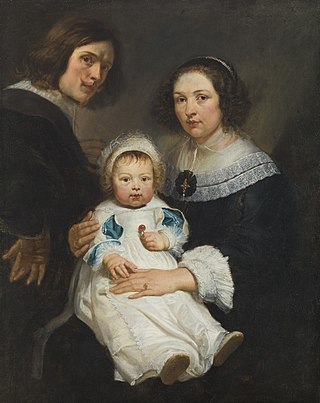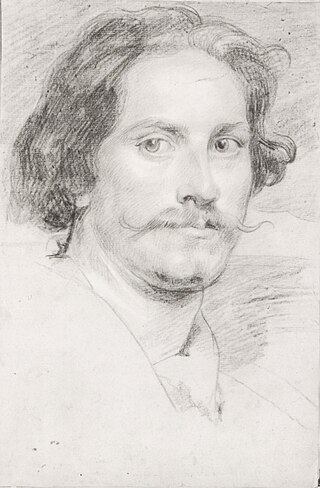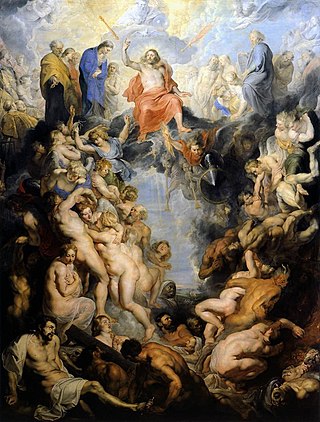
The Alte Pinakothek is an art museum located in the Kunstareal area in Munich, Germany. It is one of the oldest galleries in the world and houses a significant collection of Old Master paintings. The name Alte (Old) Pinakothek refers to the time period covered by the collection—from the fourteenth to the eighteenth century. The Neue Pinakothek, re-built in 1981, covers nineteenth-century art, and Pinakothek der Moderne, opened in 2002, exhibits modern art. All three galleries are part of the Bavarian State Painting Collections, an organization of the Free state of Bavaria.

The Assumption of the Virgin Mary or Assumption of the Holy Virgin, is a painting by Peter Paul Rubens, completed in 1626 as an altarpiece for the high altar of the Cathedral of Our Lady, Antwerp, where it remains.

The Royal Museum of Fine Arts Antwerp is a museum in Antwerp, Belgium, founded in 1810, that houses a collection of paintings, sculptures and drawings from the fourteenth to the twentieth centuries. This collection is representative of the artistic production and the taste of art enthusiasts in Antwerp, Belgium and the Northern and Southern Netherlands since the 15th century.

Erasmus Quellinus the Younger or Erasmus Quellinus II was a Flemish painter, engraver, draughtsman and tapestry designer who worked in various genres including history, portrait, allegorical, battle and animal paintings. He was a pupil of Peter Paul Rubens and one of the closest collaborators of Rubens in the 1630s. Following Rubens' death in 1640 he became one of the most successful painters in Flanders. He was a prolific draughtsman who made designs for decorative programmes in the context of official celebrations, for publications by the local publishers and for tapestries and sculptures realised by the local workshops. His work reveals the Classicist trend in the Baroque.

Jan Boeckhorst or Johann Bockhorst was a German-born Flemish Baroque painter and draughtsman who worked most of his career in Antwerp. He was a versatile artist who produced history paintings, genre scenes and portraits in a style influenced by the trio of leading Antwerp painters Peter Paul Rubens, Anthony van Dyck and Jacob Jordaens. Boeckhorst also worked as a designer of cartoons for tapestries.

Sir Peter Paul Rubens was a Flemish artist and diplomat. He is considered the most influential artist of the Flemish Baroque tradition. Rubens's highly charged compositions reference erudite aspects of classical and Christian history. His unique and immensely popular Baroque style emphasized movement, colour, and sensuality, which followed the immediate, dramatic artistic style promoted in the Counter-Reformation. Rubens was a painter producing altarpieces, portraits, landscapes, and history paintings of mythological and allegorical subjects. He was also a prolific designer of cartoons for the Flemish tapestry workshops and of frontispieces for the publishers in Antwerp.

Isabella Brant, a portrait drawing, was executed in Antwerp around 1621, by Flemish artist and diplomat, Peter Paul Rubens (1577–1640). Brant (1591–1626) was Rubens' first wife and modelled for some of his portraits until her untimely death in 1626. The portrait is drawn in black and red chalk with white heightening on brown wash paper.

Venus with a Mirror is a painting by Titian, now in the National Gallery of Art in Washington, DC, and it is considered to be one of the collection's highlights.

Prometheus Bound is an oil painting by Peter Paul Rubens, a Flemish Baroque artist from Antwerp. Influenced by the Greek play, Prometheus: The Friend of Man, Peter Paul Rubens completed this painting in his studio with collaboration from Frans Snyders, who rendered the eagle. It remained in his possession from 1612 to 1618, when it was traded in a group of paintings completed by Rubens, to Englishman Sir Dudley Carleton in exchange for his collection of classical statues. This work is currently in the collection of the Philadelphia Museum of Art.

The Great Last Judgement is an oil on canvas altarpiece, painted by the Flemish artist Peter Paul Rubens between 1614 and 1617. He created the composition and final touches and his is the only signature on the work, though it is believed between nine and nineteen studio assistants also worked on it. Its name distinguishes it from the same artist's The Small Last Judgement of 1619 and his The Fall of the Damned of 1620.

Portrait of a Commander or A Commander Being Dressed for Battle is a portrait of an unknown man in plate armour, by Peter Paul Rubens. In July 2010 it was sold for £9 million by Christie's after Sotheby's turned it down, suspecting its authenticity as a Rubens. In December 2011, the portrait was placed on loan with the Metropolitan Museum of Art in New York.

Medusa is a c.1618 painting by the Flemish painter Peter Paul Rubens, showing the severed head of Medusa. The snakes in the painting have been attributed to Frans Snyders. Frans Snyders also helped Peter Paul Rubens with his work Prometheus Bound, where he painted the eagle portrayed in it. It is in the collection of the Kunsthistorisches Museum in Vienna. Another version is held in Moravian Gallery in Brno. Rubens was not originally attributed to the painting. Medusa was a popular iconographic symbol at the time due to the interest in Greek mythology by numerous Baroque artists such as Rubens and Caravaggio. The use of Medusa as a symbol has evolved over the course of centuries and has various interpretations of the iconographic meaning, with Rubens' painting based on an interpretation of the Greek mythological story of Medusa.

The Rape of Ganymede is a painting by the Flemish Baroque painter Peter Paul Rubens produced between 1636 and 1638 painting for the Spanish king Philip IV of Spain's hunting lodge. The painting is based on a story recounted in classical poet Ovid's Metamorphoses. It depicts the moment when the Roman supreme god Jupiter disguised as an eagle catches the young shepherd Ganymede and lifts him into the air. It is in the collection of the Museo del Prado in Madrid. The dramatic scene gave Rubens ample opportunity to show his skill in depicting a lively scene and the nude.

The Garden of Eden with the Fall of Man or The Earthly Paradise with the Fall of Adam and Eve is a painting by Peter Paul Rubens (figures) and Jan Brueghel the Elder. It is housed in the Mauritshuis art museum in The Hague, Netherlands. The painting depicts the moment just before the consumption of forbidden fruit and the fall of man.

Portrait of Susanna Lunden or Le Chapeau de Paille is a painting by Peter Paul Rubens, in the National Gallery, London. It was probably painted around 1622–1625.

In 1635, Peter Paul Rubens created Venus and Adonis, now in the Metropolitan Museum of Art, New York. He followed the mythological story in the Metamorphoses by Ovid, inspired from his love of classical literature and earlier depictions of this scene. This oil on canvas painting shows Venus accompanied by Cupid, embracing and pulling Adonis before he goes off to hunt. The artist uses specific colors, detail and strong contrast between light and dark to depict a dramatic and emotional scene. At the time Rubens created the painting, the mythological story of Venus and Adonis was popular in Renaissance and Baroque court art. Rubens was clearly inspired by the many existing depictions of this scene, in particular the famous Titian composition of the same name, of which there are numerous versions. This depicts the same moment of Adonis leaving Venus to hunt, despite her pleas to stay. He is killed later in the day.
The Fall of the Rebel Angels may refer to:

Saint Teresa of Ávila's Vision of the Holy Spirit is an oil on panel painting of Teresa of Avila by Peter Paul Rubens, executed c. 1614, now in the Fitzwilliam Museum in Cambridge, to which it was allocated by the UK Government in 1999 after being accepted in lieu of inheritance tax. It is one of three versions Rubens produced of the subject, the others are in Rotterdam and a private collection.

The Fall of the Rebel Angels is an oil on panel painting by Flemish painter Frans Floris. The painting was the central panel of a triptych. The side panels, however, were lost during the iconoclastic fury in the summer of 1566. The scene represented in the painting stems from Chapter 12 of the Book of Revelation. It is one of Floris' most renowned works, often credited as his most famous painting. Floris painted it for the fencer's guild of Antwerp, one of the city's militias, responsible for public security. The altarpiece hung in the Cathedral of Our Lady in Antwerp, above the guild's altar. Like every other guild or corporation, the fencers had a patron saint, in this case, the Archangel Michael, who leads God's angels against the rebels in the painting.
The Fall of the Damned is a painting by Peter Paul Rubens.



















